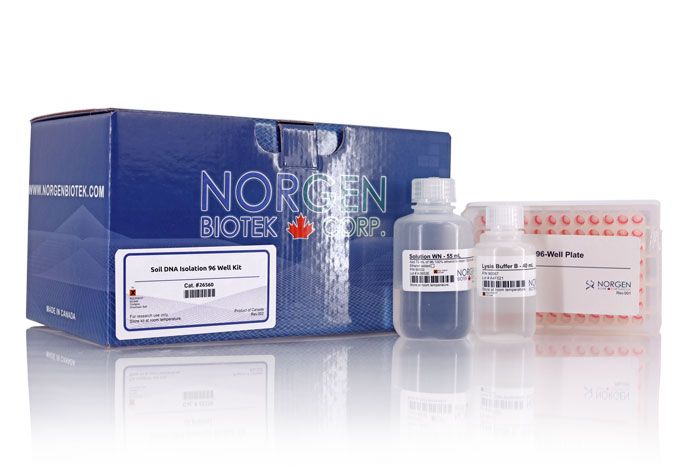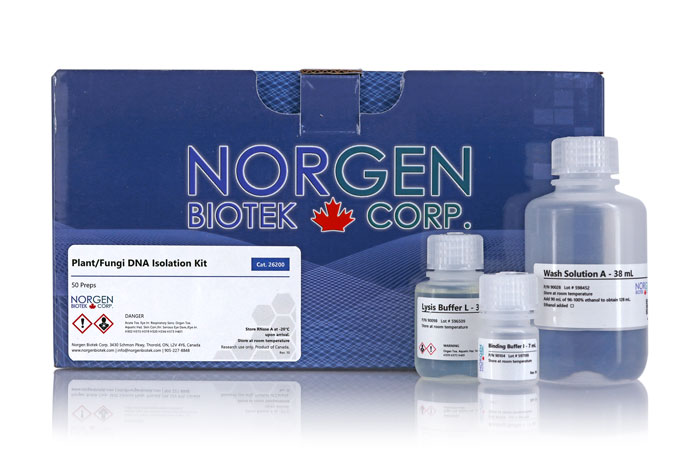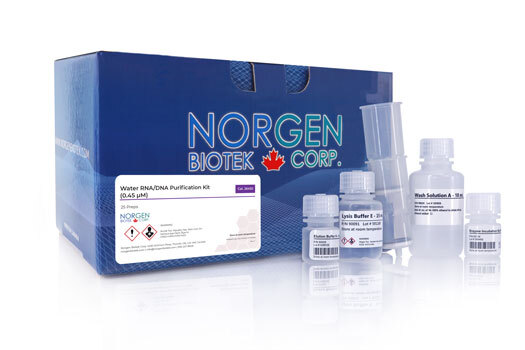Soil DNA Isolation 96-Well Kit
Rapid, high throughput purification of DNA from soil samples

For research use only and NOT intended for in vitro diagnostics.
Soil DNA Isolation 96-Well Kit
Rapid, high throughput purification of DNA from soil samples
Register today to receive an exclusive 15% off* on your first order.
Features and Benefits
- Fast and easy high throughput processing using either a vacuum manifold or centrifugation
- Process all soil types including clay, loam, sandy soils and high humic content soils such as peat, compost and manure
- Remove organic substances using the OSR Solution
- Remove all humic acid from DNA samples using the Humic Acid Removal plate
- Isolate high quality total DNA from all soil types - ready for any downstream PCR, qPCR
- Excellent DNA for metagenomic studies
- No phenol or chloroform extractions
This kit provides a fast, reliable and simple procedure for high throughput isolation of DNA from all types of soil samples including common soil samples and difficult soil samples with high humic acid content such as compost and manure. A combination of chemical and physical homogenization effectively lyses all microorganisms in the soil sample, and the kit removes all traces of humic acid using the provided Organic Substance Removal (OSR) Solution and Humic Acid Removal plate (HAR). Total genomic DNA can be isolated and purified from all the various microorganisms found in soil, such as bacteria, fungi and algae. The purified DNA is of the highest quality and is fully compatible with downstream PCR and qPCR applications and more for any metagenomic study, as all humic acid substances and PCR inhibitors are removed during the isolation.
Details
Supporting Data
Figure 1. Consistent Yield of High Quality of Soil DNA. Total soil DNA was isolated from gardening top soil samples using Norgen's Soil DNA Isolation 96-Well Kit. For analysis, 10 µL from each 100 µL elution from 10 different wells was run on a 1.2% TAE agarose gel. Lane M is Norgen's High Ranger DNA ladder.
Figure 2. Consistent and high DNA quality. Total DNA was isolated from gardening top soil using Norgen's Soil DNA Isolation 96-Well Kit. For analysis of DNA quality, 3 µL from each 100 µL elution was used as the template in a real-time PCR reaction (SYBR Green) for the detection of the 16s rDNA. All DNA template from different wells showed a consistent Ct, indicating the consistent high DNA quality and yield. Black circle: NTC.
|
Kit Specifications
|
|
|
Binding Capacity Per Well
|
50 μg
|
|
Maximum Loading Volume Per Well
|
500 μL
|
|
Size of DNA Purified
|
All sizes |
| Maximum Amount of Starting Material |
250 mg
|
|
Time to Complete 96 Purifications
|
50 minutes |
Storage Conditions and Product Stability
All solutions should be kept tightly sealed and stored at room temperature. This kit is stable for 1 year after the date of shipment.
| Component | Cat. 26560 (192 preps) |
|---|---|
| Lysis Buffer G | 2 x 100 mL |
| Lysis Additive A | 25 mL |
| Binding Buffer I | 25 mL |
| OSR Solution | 12 mL |
| Wash Solution A | 2 x 38 mL |
| Elution Buffer B | 30 mL |
| Bead Tubes | 200 |
| HAR Plate | 2 |
| 96-Well Filter Plate | 2 |
| Adhesive Tape | 4 |
| 96-Well Collection Plate | 4 |
| 96-Well Elution Plate | 2 |
| Product Insert | 1 |
Documentation
FAQs
High Throughput
Poor DNA recovery could be due to one or more of the following:
- Homogenization was incomplete.
Depending on the type of soil, optimization of the homogenization with the flat bed vortex or bead beater equipment may be required. However, it is not recommended to increase the vortex time to longer than 10 minutes at maximum speed.
- Lysis Additive A was not added to the lysate.
Ensure that the provided Lysis Additive A is added to separate humic acid and increase DNA yield.
- 96-100% Ethanol was not added to the lysate.
Ensure that the indicated amount of 96-100% ethanol is added to the lysate before binding to the column.
- Ethanol was not added to the Wash Solution A.
Ensure that the indicated amount of 96-100% ethanol is added to the supplied Wash Solution A prior to use.
If the DNA does not perform well in downstream applications, it may be due to one or more of the following:
- Eluted DNA sample is brown.
The elution contains high humic acids. Ensure that the OSR Solution was added to the clean lysate, followed by the HAR plate step to remove humic acids.
- DNA was not washed with the provided Buffer SK and Wash Solution A.
Traces of humic acids or salt from the binding step may remain in the sample if the column is not washed with the provided Buffer SK and Wash Solution A. Humic acids and salt may interfere with downstream applications, and thus must be washed from the column.
- Ethanol carryover.
Ensure that the dry spin under the Wash procedure is performed and pat the bottom of the 96-Well Filter plate on a clean paper towel to remove the residual wash solution. Ethanol is known to interfere with many downstream applications.
- PCR reaction conditions need to be optimized.
Take steps to optimize the PCR conditions being used, including varying the amount of template (10 ng to 50 ng for 20 µL of PCR reaction is recommended), changing the source of Taq polymerase, looking into the primer design, and adjusting the annealing conditions.
Citations
| Title | Effects of digestate-encapsulated biochar on plant growth, soil microbiome and nitrogen leaching |
| Citation | Journal of Environmental Management 2023. |
| Authors | Miao Yan a b 1, Hailin Tian b c 1, Shuang Song d, Hugh T.W. Tan d, Jonathan T.E. Lee b e, Jingxin Zhang f, Pooja Sharma b, Yong Wei Tiong b, Yen Wah Tong g |
| Title | Metagenomic and satellite analyses of red snow in the Russian Arctic |
| Citation | PeerJ 2015. |
| Authors | Nao Hisakawa1 , Steven D. Quistad1 , Eric R. Hester1,2 , Daria Martynova3,4 , Heather Maughan5 , Enric Sala6 , Maria V. Gavrilo4 and Forest Rohwer |


